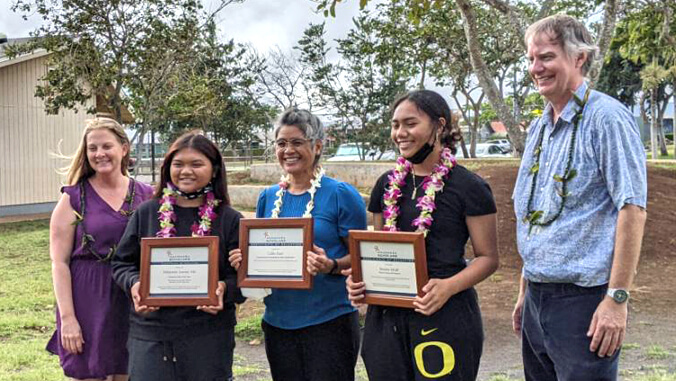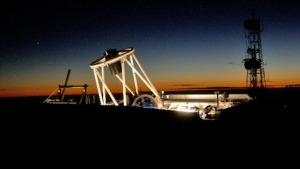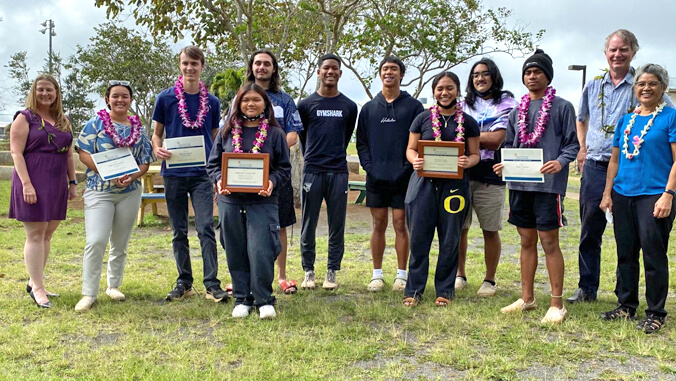
An inaugural cohort of Maunakea Scholars at Lānaʻi High School were rewarded for their research efforts by earning opportunities to explore the universe with some of Hawaiʻi’s most powerful telescopes. The Maunakea Scholars program announced three students will be given time to use telescopes on Maunakea and Haleakalā to conduct their own astronomical research projects.
This is the first time since the program’s inception in 2015 that student proposals from Lānaʻi High School have been awarded telescope time. Throughout the history of the program, Maunakea Scholars has worked with more than 600 public school students statewide.

“I was shocked to hear my name announced. Not only did I receive telescope time, but my first round of observations were taken last night. Seeing my observations on the screen amazed me,” said Mackenzie Lamay-Aki, one of the Lānaʻi student awardees.
Mentors from the University of Hawaiʻi Institute for Astronomy (IfA) worked with students for months preparing professional-style research proposals. The proposals were reviewed by a committee composed of professional astronomers. The student projects were selected based on technical viability, creativity and science impact.
Lānaʻi High School students with winning proposals
- Callie Hart was awarded observing time with the Las Cumbres Observatory for her proposal “Comparing and Contrasting Stellar Classification.”
- Souina Seiuli was awarded observing time with the NASA Infrared Telescope Facility for her proposal “Rings of Saturn and Neptune.”
- Lamay-Aki was awarded observing time with the W. M. Keck Observatory for her proposal “Companion Stars Over Time.”
Maunakea Scholars works with Hawaiʻi public school students to bring high schoolers into one of the world’s most advanced observatory communities. The program empowers students to envision themselves as aspiring astronomers, engineers and other STEM-related professionals. It is the first program of its kind internationally to allocate observing time at major observatories for the direct educational advancement of high school students. To qualify, students in participating schools write a proposal to conduct their own, independent research that can be conducted at an observatory. Selected proposals are then matched with graduate students from IfA and telescope staff to individually guide them through their research.
“Maunakea Scholars provided an incredible opportunity and confidence boost for my students,” said Kapua Weinhouse, a chemistry science teacher at Lānaʻi High School. “When we started the program at the beginning of the school year, I did not dream that a student from Lānaʻi would receive observing time at the W. M. Keck Observatory. I am so proud of the work my students put in over the course of the year on their projects.”
The 2021-22 Maunakea Scholars included students from seven local schools: Kalani High School, Kapolei High School, and Waipahu High School on O‘ahu; Waiākea High School and Kealakehe High School on Hawaiʻi Island; Molokaʻi High School; and Lānaʻi High and Elementary School. The Maunakea Scholars Program works with education partners at ʻImiloa Astronomy Center and all the Maunakea Observatories facilities, Las Cumbres Observatory and the Daniel K. Inouye Solar Telescope.
- Related UH News story: Waipahu students win telescope time through Maunakea Scholars Program, February 16, 2022
“It is gratifying to spark fascination in science among students then watch them gravitate toward their exploration passions,” said Doug Simons, IfA director. “What makes it even more special is extending valuable opportunities to our keiki from rural communities and the neighbor islands.”
Initiated by Canada-France-Hawaiʻi Telescope and Gemini Observatory, and in partnership with the Maunakea Observatories and the Hawaiʻi State Department of Education, Maunakea Scholars was launched to bring Hawaiʻi’s aspiring young astronomers into the observatory community.
This program is an example of UH Mānoa’s goal of Enhancing Student Success (PDF) and Excellence in Research: Advancing the Research and Creative Work Enterprise (PDF), two of four goals identified in the 2015–25 Strategic Plan (PDF), updated in December 2020.


